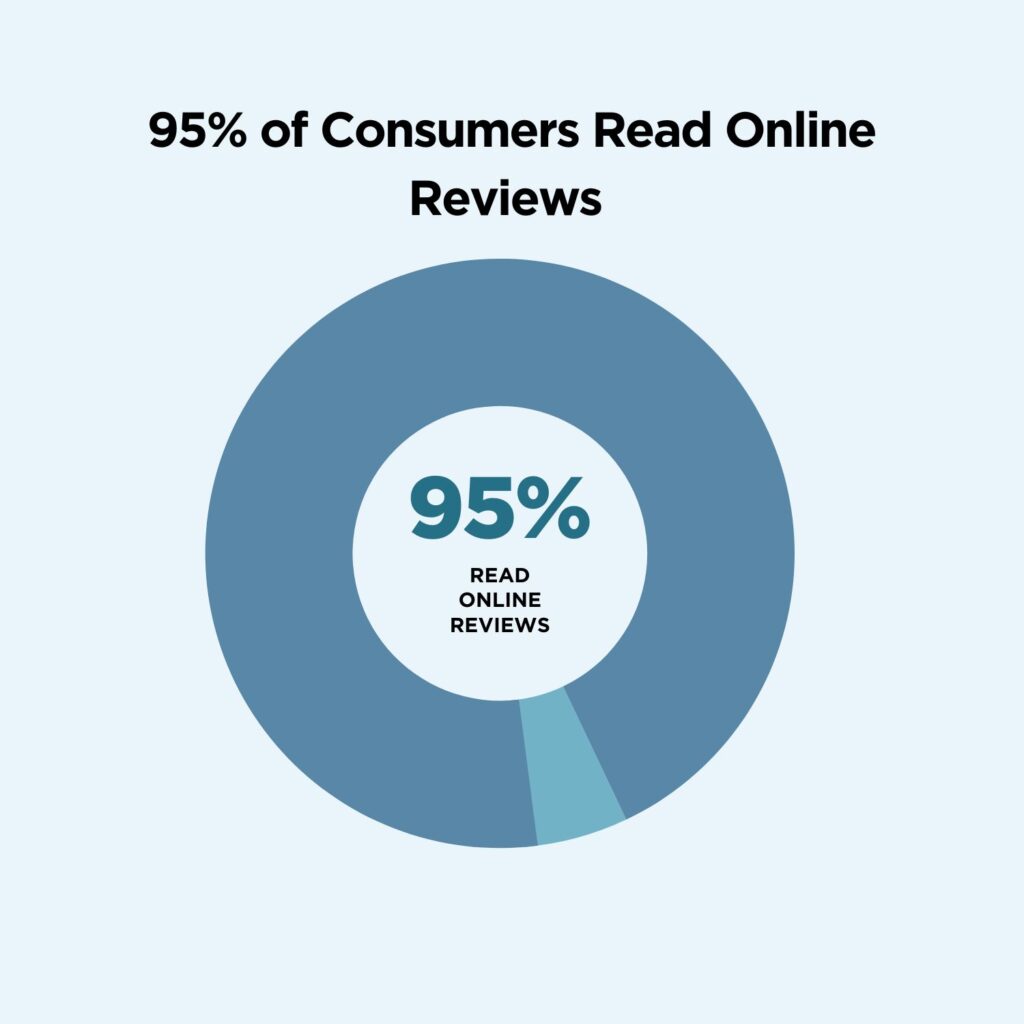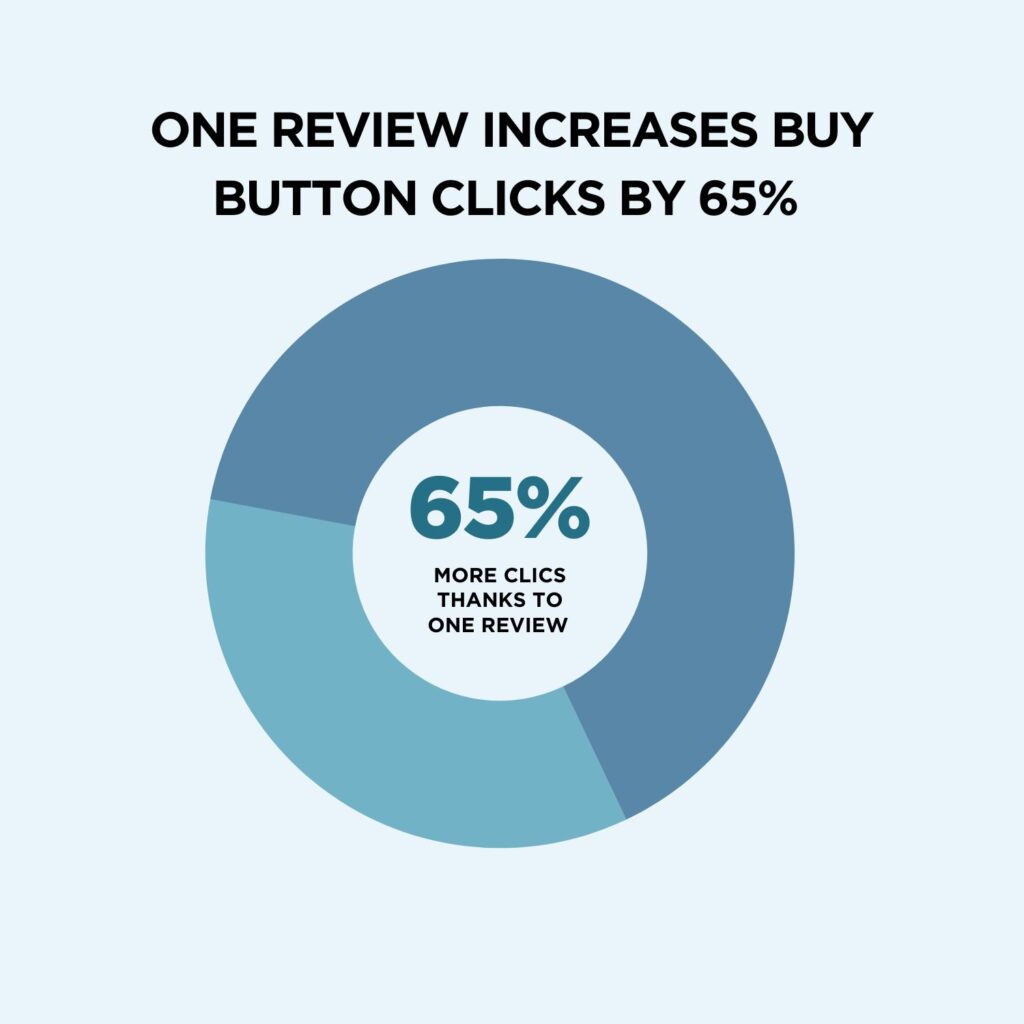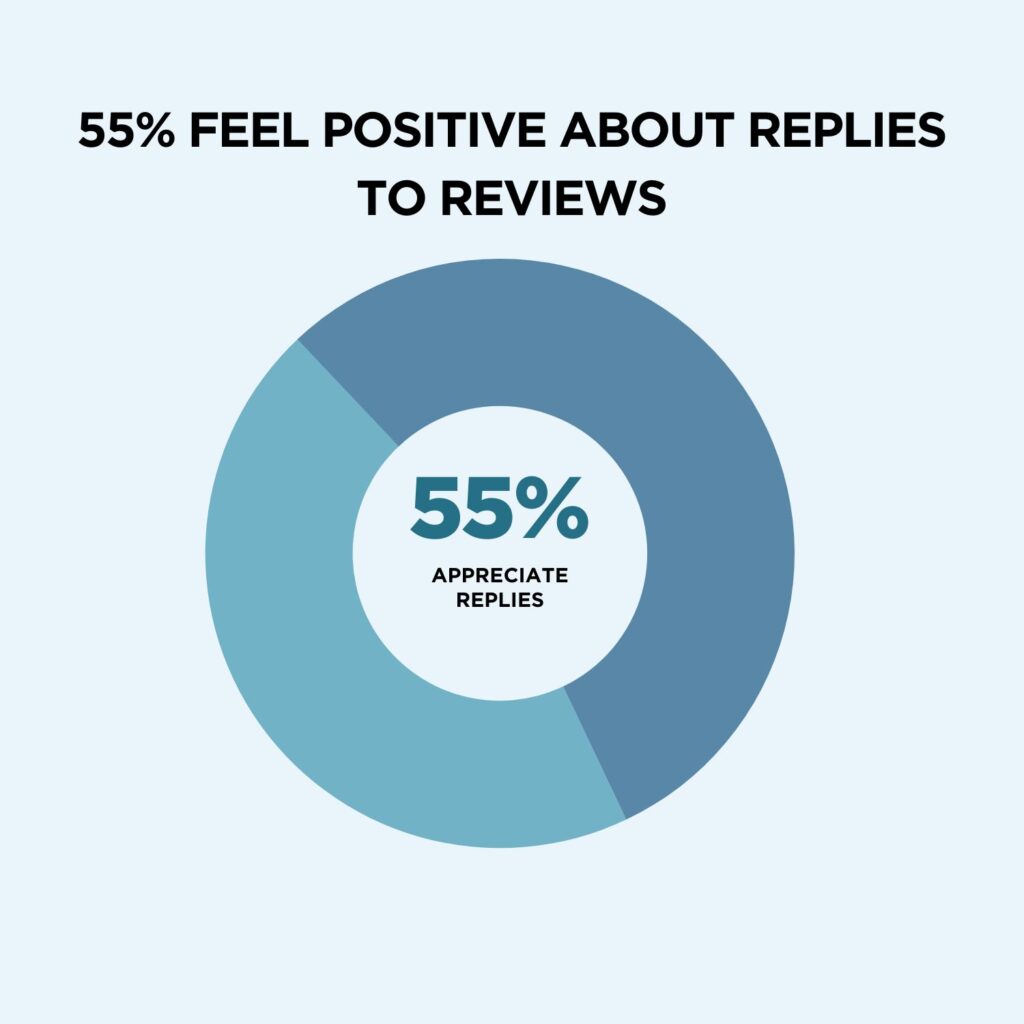We all know online reviews are essential to any online business. Today’s consumer is savvy and it’s proven that the majority of online shoppers research products before purchase, oftentimes, looking for online reviews.
That means online reviews are effectively swaying purchasing decisions and spending habits but by how much?
And…
- What percentage of customers write reviews?
- How many businesses respond to reviews?
In this article, we’re uncovering a definitive list of online customer review statistics. This ample list of facts and figures will give you the ultimate understanding of how powerful online reviews are.
Ready, set, let’s go!
The top online review statistics in 2024
- 95% of customers read online reviews before buying a product
- 89% of consumers make an effort to read reviews before buying products online
- 49% of consumers trust online reviews as much as personal recommendation
- 94% say reviews have made them avoid a business
- 97% read reviews for local businesses
- Positive reviews can increase customer spending by 31%
- Over 81% of consumers say they are likely to check Google reviews first
- 74% of consumers say that reviews increase trust in a company
- 53% of consumers expect brands to respond to negative reviews within a week
- 68% don’t trust a 5-star rating unless there are more reviews
How many people rely on online reviews?
1. 95% of customers read online reviews before buying a product
(Global Newswire)
Over nine out of ten customers (95%) read product reviews before they choose to purchase something. Additionally, 58% of these shoppers say they are willing to pay more for products that have good reviews.

2. 89% of global consumers say checking online reviews is part of their buying journey
(Trustpilot)
Around 89% of consumers say they make an effort to read reviews before buying products online. Checking reviews have become the norm and part of the shopping process and reviews matter—a lot. That’s why 49% of these global consumers consider positive reviews one of their top three influences for purchasing a product.
3. 49% of consumers trust online reviews as much as personal recommendations
(Bright Local)
Almost half of the consumers trust reviews as much as a personal referral from friends or family. This 49% of trusting consumers is a drop from last year, where 79% reported the same response. Why? Consumers are getting smarter and can now tell the difference between authentic reviews and those left by influencers or paid programs.
4. 36% of consumers online use reviews to inform their purchase decisions
(Statista)
According to a global study, 36% of internet users aged 25 to 34 use online reviews for brand and product research. 17% of U.S. online shoppers always check online reviews before purchasing a product and 38% say they are “very important” in helping them decide.
5. 92.4% of respondents say reading a trusted review makes them more likely to purchase a B2B product
(G2)
Are you more likely to purchase a product or service after reading a trusted review about it? Apparently, yes. Over 92% admit authentic reviews persuade them to make a purchase. But, shockingly, only 1 in 5 companies considered adding reviews to their marketing strategy.
6. 7 out of 10 consumers admit to using rating filters when browsing businesses
(Review Trackers)
A business’ star rating can greatly help or hurt the chances of being found online. As many as 70% of internet users admit to using rating filters when searching for businesses. The most commonly used filter was for companies with 4-stars and higher.
7. If consumers found out a platform was censoring reviews, 62% of consumers would stop using it
(Trustpilot)
People trust reviews because review censorship is not tolerated. 62% of global consumers say they would stop using a platform for good if they found reviews were censored. 70% of these respondents think that the censorship of customer reviews is a “serious” concern. 42% believe it damages freedom of speech and 45% think review censorship will lead to wasted money.
What percentage of people read online reviews?
8. 98% of people “occasionally” read online reviews for local businesses
(Bright Local)
Online review statistics show that nearly all internet users have at some point, or “occasionally,” looked at online reviews for local businesses. Meanwhile, 77% “always” or “regularly” read these localized online reviews. This figure is up from 60% in 2020. How many people “never” read reviews for local businesses? Just 2% (way down from 13% in 2020).
9. The average consumer reads 10 reviews before trusting a business
(Statista)
The average number of reviews that American consumers need to read before trusting a business is 10. But, 31% of consumers read more than 10 reviews (up to 55+) before this trust is formed. Younger age groups said they need to read more reviews than this average before they can trust a business.
10. Almost 55% of consumers read at least 4 reviews prior to purchasing
(Bizrate Insights)
According to a survey, over half (54.7%) of consumers read a minimum of four reviews before they decide to purchase something. The remaining sum, about 44%, admit they read three or fewer consumer reviews.
11. 85% of consumers don’t think older reviews are relevant
(Bright Local)
When we say “older reviews,” we aren’t referring to those from last year. We mean that 85% of consumers don’t think reviews older than 3 months are relevant. 40% of those surveyed only cared about reviews less than two weeks old.
12. Online reviews have gotten 65% shorter in the past decade
(Review Trackers)
Since 2010, the average length of a consumer online review has dropped from 600 characters to just over 200. That’s about the same length as an expanded tweet. Reviews may be getting shorter but more people are leaving more reviews than ever.
How effective are online reviews?
13. One review increases internet users clicking the “buy” button by 65%
(USA Today)
When a product goes from zero reviews to displaying just one, the rate that internet users actually click the purchase button skyrockets by 65%. According to one analyst, the review count sweet spot is 20 for a product to fit in the market competitively.

14. 52% of a company’s market value is attributed to its reputation
(PR Week)
If a company is determining its market value, reputation is over half the battle. Almost 92% said that, at a minimum, a quarter of the company’s market value should be attributed to reputation. Consumer reviews are proof of a company’s reputation amongst the public, so they’re more important than one might realize.
15. 88% of customers who read an online review say it influenced their buying decision
(Zendesk )
In short, online reviews are extremely effective considering they affect nearly 9 in 10 people’s purchasing decisions. 97% reported bad customer service changed their buying behavior while 87% admitted that good customer service changed it.
16. The average dissatisfied customer tells 9 to 15 people about a bad experience
(Inc.)
Word-of-mouth marketing is one of the most effective marketing strategies, but it works in reverse. Online review statistics show that one unhappy customer typically tells between 9 and 15 other people, and some tell 20 or more. That’s probably one reason why a bad review can lead 86% of consumers to quit buying from a business.
17. Displaying online reviews increases conversion by 270%
(Spiegel Research Center)
The probability of a product selling skyrockets if it is displayed with reviews. Online products with at least five reviews experienced four times the purchase likelihood as product pages without, translating to 270% more conversions. The first five reviews for a product have the biggest conversion impact.
18. Higher-priced items with reviews experience 190% higher conversion rates than lower-priced products
(Spiegel Research Center)
Online reviews increase the conversion rates for all products substantially, however, higher-priced goods perform even better. Reviews displayed with a lower-priced item saw conversions increase by 190%, while higher-priced items saw a conversion rate of double that at 380%.
19. 40% of consumers say reviews build credibility for the product
(G2)
Online reviews are also effective at building credibility for a product, for 39.5% of people. 72% of buyers appreciate negative reviews on products and services, saying that these “help provide depth and insight to make a decision.” 67% of consumers want a mix of both positive and negative reviews.
20. 25% of U.S. shoppers think online reviews are important
(Statista)
According to Statista, 25% of consumers in the United States believe that customer product reviews are important when choosing an online retailer. At the same time, 62% of consumers said online customer reviews are “very helpful.”
21. Positive reviews can increase customer spending by 31%
(Bright Local)
Positive reviews don’t just attract customers to a business, they actually increase customer spending by over 30%. That’s because consumers are reported to spend 31% more on products or services that have excellent reviews. On the opposite side of the spectrum, a negative review can drive away 40% of potential customers.
22. 74% of consumers say that reviews increase trust in a company
(Finances Online)
Building trust is vital for a company to remain successful, and reviews are a way to do that. 74% of consumers think that reviews help increase trust. In addition, 73% of consumers say they trust a local business more if it has positive reviews.
23. Most people, 68%, don’t trust a high review rating unless there are a lot of reviews
(Podium)
68% of consumers either “agree” or “somewhat agree” that a high review rating is not trustworthy unless there is a high quantity of reviews. Another 83% don’t care about reviews unless they are recent and relevant.
24. 3.4 stars is the average rating for consumers to consider a business
(Podium)
For consumers to consider engaging with a business, they require it to have an average of a 3.4-star rating. 38% of customers require a minimum of a 4-star rating to consider engaging. For businesses that yield only a 1 or 2-star rating, only 9% of consumers would consider working with them.
What are negative online review statistics?
25. One negative review requires roughly 40 positive reviews to outweigh the damage
(Inc.)
One analyst created a ratio for online consumer reviews. To fix the damage that one negative review online causes, a business must attract about 40 positive reviews. This is largely due to the fact that only one in ten happy customers is likely to leave a review, while unhappy customers are more likely to leave a bad review.
26. Consumers spend 4x as long on a site when interacting with negative reviews
(Spiegel Research Center)
Did you know that even negative online reviews have a positive effect? When consumers interact with negative reviews, they spend four times as long on the website and causing a 67% increase in conversion rate.
27. More people share negative reviews than good, but not by much: 49% vs. 38%
(Zendesk)
A survey of 1,004 respondents showed that on social media, 49% of consumer reviews communicated poor experiences about a business. Meanwhile, 38% of these social media consumer reviews shared positive experiences. The trend was similar on review websites, with 46% showing bad reviews and just 27% sharing good feedback.
28. 45% of consumers would consider hesitating from leaving a negative online review due to the business’ current operating challenges
(Podium)
Nearly half of the consumers who would normally leave a negative review said that they would now hesitate. Why? Because “they want to try to be more understanding of business’ operating challenges,” especially since COVID-19. Maybe this is why 42% of businesses say their online reputation has improved since the pandemic.
How many people care about responses to reviews?
29. 55% of consumers said if a business owner responds to their review, they would feel positive about a business
(Bright Local)
Of consumers that leave reviews, over half (55%) would feel good about a business if someone responds to their feedback. And this principle doesn’t just apply to your personal reviews, but others. 89% of consumers are “highly” or “fairly” likely to use a business if it responds to all of its online reviews. On the flip side, 22% admit it’s “not likely at all” for them to choose a business that doesn’t respond to any reviews online.

30. Over half of the consumers expect businesses to reply to negative reviews in less than one week
(Review Trackers)
People don’t just care about responses to reviews, but they want fast responses. Over half (53%) of consumers expect a reply to a negative review within a week. One-third of consumers expect this response in just 3 days or less.
31. 56% of customers said that a company’s response to a review changed their perspective
(Podium)
A business’ response to a review can shift the perspective of over half (56%) of consumers. Survey respondents said that a review response from a business offers “insight into how responsive, responsible, and caring a business is.” 23% of respondents said a response would not change their mind and 21% was unsure.
| Consumer sentiment | % of consumers |
| Would change their mind | 56% |
| Would not change their mind | 23% |
| Unsure | 21% |
32. 45% of consumers report that they are more likely to visit a business if it responds to bad reviews
(Review Trackers)
94% of consumers admit that a bad review made them avoid a business. However, 45% said they are more likely to visit a business if it responds to negative reviews. Sadly for businesses, an astonishing 63% say that at least one company they reviewed never replied to them. This leaves a huge opportunity for businesses to improve!
What percentage of people leave online reviews?
33. Only 5% to 10% of customers actually write reviews
(USA Today)
What percentage of customers write reviews? It turns out that just 5 to 10% of consumers go on to write them. Regardless, an expert analyst estimates that online reviews fuel about 20% of sales. When this metric is applied to global e-commerce sales of $2 trillion, online reviews brought it more than $400 billion.
34. 52% of global internet users aged 25-34 post reviews online
(Statista)
Worldwide, over half of the consumers in this age range say that they post reviews online. What is the leading reason why people leave reviews? The primary reason given was “to inform others about their customer experience.” However, overall product performance and buyer satisfaction were ranked as the two most helpful factors when reading online reviews.
35. When prompted, 12% of consumers will always leave a review
(Bright Local)
A survey asked consumers if they had been prompted by a business in the last 12 months to leave a review. Of those that said yes, 12% always left a review, 23% left a review half of the time, and 30% left a review sometimes. 41% were asked for this review via email, 35% on a receipt, and another 35% in person.
| Number of times consumers leave reviews | Percentage |
| Always | 12% |
| Half the time | 23% |
| Sometimes | 30% |
36. 80% of online reviews originate from follow-up emails
(Spiegel Research Center)
Many people leave online reviews, but where do they come from? Apparently, 80% of online reviews come from a friendly follow-up email from the business, simply asking for one. This also means businesses are sourcing more verified buyer reviews, which increase purchase decisions by 15% compared to anonymous reviews.
Online review of market size
37. Four websites control 88% of all online reviews
(Review Trackers)
When searching the internet for online reviews, there’s a 88% chance it’s on one of four popular websites: Google, Yelp, TripAdvisor, or Facebook. Google accounts for 73% of all reviews, then Yelp with 6%, and Facebook and TripAdvisor hosting 3%.
| Website | % of reviews |
| 73% | |
| Yelp | 6% |
| TripAdvisor | 3% |
38. A few top website directories influence 75% of new business
(Review Trackers)
Roughly 75% of new business is influenced by this handful of review sites and other business directories. These include Google, Yelp, TripAdvisor, and Facebook plus Apple Maps and Bing Maps.
39. Consumers are more than twice as likely to turn to Google to discover local businesses
(Podium)
A review on consumer behavior found that internet users are 2x as likely to choose Google over other notable sources. While 72% of consumers choose Google, 31% use Yelp, 25% reference Social Media, 12% use industry-specific sites, 10% use “other,” and 7% try Angie’s List.
Google review statistics
40. Google’s review growth rose 65% in 2020
(Review Trackers)
How does Google track if consumers are looking at online reviews? Zero-click searches, which increased to 65% in 2020. Google displays online reviews in snippets that include a star rating in the organic search results.
41. Over 81% of consumers are likely to visit Google Reviews prior to visiting a business
(Review Trackers)
Research shows that 81% of internet users report that they are likely to check Google Reviews before they visit a business in person. This percentage is up from 63.3% the year before. These same people also reported they would check Google before another review site.
42. Online reviews are 12% of the top local SEO factors for Google
(Bright Local)
Google is the world’s largest search engine and it factors in online reviews for SEO, or search engine optimization. A business looking to improve SEO on Google should work on the following factors as it makes up the local SEO ranking factors: on-page optimization (25%), links (22%), Google Business Profile (21%), and reviews (12%).
43. The average local business on Google has 39 online Google Reviews
(Bright Local)
How many reviews does the average business have on Google? On average, 39. In fact, 74% of local businesses have at least one Google review. Businesses that appear in the top 3 local positions have an average of 47 Google reviews.
44. Google Reviews, on average, give a star rating of 4.42 for local businesses
(Bright Local)
How many stars does the average business have on Google? On average, local businesses rate 4.42. The majority, 61%, have a rating between 4 and 5 stars, while just 5% have an average star rating below 3 stars.
Conclusion
That’s it! There’s a comprehensive review sharing 44 customer review statistics! Now, you know more about how many people read and care about online reviews, the internet market size, Google Reviews, and much more.
Want to learn more about asking for the best testimonials?
Sources:
Further reading:
The Ultimate List of Small Business Statistics





3 Responses
Great article, Luisa! The statistics you’ve shared truly highlight the impact of online reviews in shaping consumer behavior. It’s fascinating to see how essential reviews have become in the buying journey. Thank you for sharing this valuable information!
You’re welcome!
I’m the proof that:
“ When prompted, 12% of consumers will always leave a review”
Great article!! As a business owner I learned a lot about the importance of reviews and maintaining your reputation. I will definitely change my ways from now on!
Thank you! 🙂